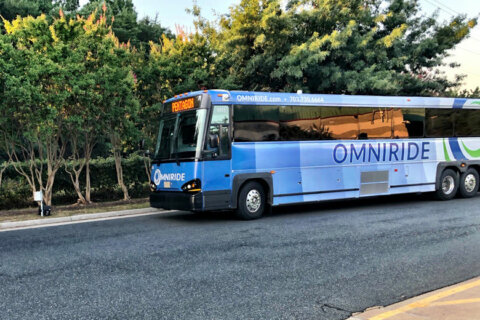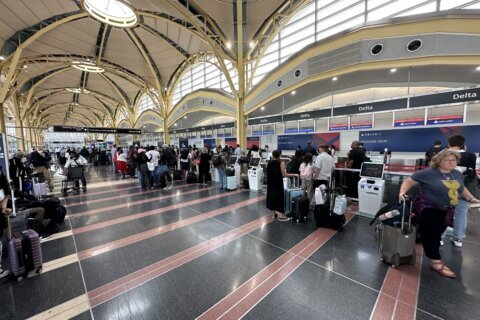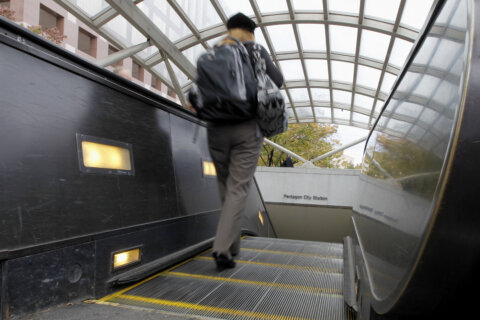Editor’s note: Making fun of D.C. traffic is nothing new, but as a veteran traffic reporter, WTOP’s Dave Dildine can do it like few others. Remember, everything written here comes from a place of love (and maybe just a smidge from a place of absolute fury).
D.C. morning rush hour starts at 5 a.m. and lasts until 4 p.m. The afternoon rush hour starts at 7 a.m. and lasts until Sunday. Friday rush hour started during the Hoover administration and will last until the end of time and space.
East-west travel through the District of Columbia is impossible, unless you’re on the Southeast-Southwest Freeway where the average speed is 90 mph. No one knows what the freeway is called or numbered though. Some people call it I-695. Some people call it I-395. Some people refer to it as West Side Highway.
Another busy freeway that runs through D.C. is the Potomac River Freeway. No one knows what this freeway is called either, so they simply refer to it as “that road behind the Kennedy Center.” If you need to tell someone what road you’re on, you can refer to it as “that road behind the Kennedy Center” but they might assume you’re talking about the E Street Expressway, which is an entirely different road.
Another freeway in the District is I-295, not to be confused with DC-295. Local authorities always refer to I-295 as DC-295 and DC-295 as I-295, possibly to mess with people or possibly because they genuinely don’t know the difference. The average speed on DC-295 is a relaxed 80 mph. The average is lowered by drivers slamming on their brakes near the speed cameras and hairpin exit ramps. DC-295 is also congested 28 hours a day, 10 days a week.
DC-295 and I-295 are often conflated, even though the whole corridor is named the Anacostia Freeway. Except DC-295 isn’t a freeway. It’s actually an urban expressway. It’s also Kenilworth Avenue. Except technically, only the service road in Northeast is Kenilworth Avenue.
That is, until you get to the Maryland state line where the entire six-lane roadway suddenly becomes Kenilworth Avenue. But only for a quarter of a mile up to U.S. Route 50, where the same stretch of road that just turned from DC-295 to Kenilworth Avenue changes to MD-295. Except MD-295 isn’t signed because that would be too easy. Instead, the road is known as the Baltimore-Washington Parkway until you get past Fort Meade, where the parkway is known as MD-295. Still with me?
The D.C. automated speed enforcement program nets about $800 billion annually, roughly the GDP of Switzerland. And 99.9% of the revenue comes from one camera located on the tunnel-expressway portion of K Street below Washington Circle, where there are no pedestrians and there is no cross-traffic, yet the speed limit is curiously set at 25 mph. The rest of the revenue comes from tickets with doubled fines that were erroneously issued outside of work zones.
The Baltimore-Washington, Clara Barton, George Washington and Rock Creek parkways are scenic byways through bucolic national forestland on which hundreds of thousands of commuters take gentle curves at breakneck speed. There are tens of thousands of crashes on the GW Parkway near Key Bridge annually. There is one there right now.
Whenever it drizzles, eager northbound drivers will line up in excitement on the GW Parkway and take turns spinning out and overturning on the ramp to the Inner Loop of the Capital Beltway. Bonus points are awarded to anyone who manages to snap a yellow chevron sign on their off-road adventure.
There are several spinout leagues around the region. Another popular meetup spot is the ramp from DC-295 to the 11th Street Bridge. Note: The southbound exit number for the bridge is Exit 1, but if you’re northbound, Exit 1 is Pennsylvania Avenue for some reason that transcends comprehension.
On the District’s freeway system, there are roughly a trillion Exit 1s within about three miles of each other. If you’re involved in a crash, make sure to tell the dispatcher that you’re at Exit 1, so dozens of rescue personnel take at least an hour looking for you on the wrong road. If your car becomes disabled on the westbound Southeast-Southwest Freeway’s northbound South Capitol Street ramp, you will never be found.
One of the DMV’s favorite Friday activities is to collectively decide to drive to the Eastern Shore at the exact same time. By the time you approach the Chesapeake Bay Bridge, it will be raining. The weather-closure of the reversible lane will cause shore-bound traffic to backup into Ohio.
On the Friday before Memorial Day, delays usually begin closer to Peoria. Desperate drivers will self-divert onto smaller roads through Annapolis and, for some reason, local authorities think simply telling drivers who have been sitting in traffic for five hours not to detour to other public roads will actually keep them from doing so.
Due to an obscure federal law, all journeys through the capital region require travel on roads named after George Washington. Your route may take you on any of the following: Washington Avenue, Washington Street, Washington Boulevard, George Washington Road, Fort Washington Road, New Washington Road, Old Washington Road, Old Washington Boulevard, Washington Circle, Washington Lane, Washington Way, George Washington Highway, George Washington Parkway, Baltimore-Washington Parkway, or variations thereof.
If you want to take Virginia’s privately-owned express lanes and Maryland’s HOV lanes, you will need to meditate on the rules for decades before even beginning to understand the complex pricing, schedules, occupancy restrictions, reversals, exemptions and exceptions for each facility. Linking your E-ZPass to a hidden offshore shell account will be prudent for your first few years of experimentation.
Driving in Northwest D.C. during rush hour will offer you the unique experience of being on some roads that suddenly change direction at certain times of day, turning everything you’ve learned about driving to the right of the double yellow line upside down.
Twice a day, on portions of Rock Creek Parkway, Clara Barton Parkway and Canal Road, traffic reverses and flows one-way into the path of frightened tourists woefully ill-equipped to deal with local tradition. There are some small white signs with fine print that describe the various restrictions, but you won’t have time to read them because you’ll be too preoccupied with avoiding a head-on collision.
Stay alert for frantic honking and rapid headlight flashing from your fellow drivers; this will serve as a precursor to impending doom. The center lane on Chain Bridge and Canal Road is open to inbound traffic during the morning rush hour, but it’s usually empty because everyone is too terrified to use it.
A winter tradition in D.C. is to wait until it starts snowing heavily and then rush out onto the roads all at once when the snowfall rate reaches whiteout status. It is widely held that all unnecessary travel, such as buying groceries and going to the dog park, is best undertaken during extreme winter weather. The federal and local governments nurture this pastime by waiting until the absolute height of winter storms to issue early dismissals.
After it snows, residents are expected to lambaste the local transportation department for not plowing their small side street within five seconds of the last flake falling. For this reason, over-caffeinated plow operators are obligated to disgorge millions of tons of salt and navigate 40-ton trucks for 18 hours nonstop, creating untold amounts of noise, air and water pollution, even though the 2 inches of slush would have melted by sunrise on its own.
Just as church bells toll and roosters crow, tractor trailers overturn on the Outer Loop at the “Big Curve” in Bethesda to signal the dawning of a new day. The weekly jackknifing of trucks on this portion of the Beltway is also believed to drive out demons and cleanse societal impurities.
Interstate 66 has been under construction since antiquity. Road work is scheduled for completion minutes before the ultimate heat death of the universe. Rest assured, it will be humanity’s greatest legacy.
Many drivers concern themselves more with excoriating others than the act of traveling. License plates and other visible decals are scrutinized rigorously. Maryland drivers and Virginia drivers will take any petty opportunity they can to belittle each other by resorting to a trite, oversimplified inanity relating to what they perceive as their neighboring state’s inferior driving ability.
Meanwhile, D.C. drivers — with license plates that read “taxation without representation” — are happy just to sit on the sidelines and watch.








